A Complete Beginners Guide For 2020

If you’re looking for a free, easy, step-by-step guide on how to start a blog, then you’ve come to the right place. I’ve designed this guide to be beginner friendly, so I’ve gone through everything in detail.
Following the steps, you should be able to get your blog up and running in about 30 minutes. You might want to bookmark this page if you don’t have that time right now, or grab yourself a coffee and let’s crack on. If you want to skip the introductions and get straight to work on creating your blog, go to step 1. I’ll try not to take it personally.
Oh hey, you stuck around. Great! So, my name’s Matt and I’ve been blogging and creating websites for a long, loooong time. I’ve helped some of my friends start their blogs, and I figured now was the best time to extend what I’ve learnt and help a wider audience.
Whatever your goals, I’m confident that my free, step-by-step guide will get you up and running in no time. And if you do get stuck with anything, feel free to reach out and ask any questions. I mean…as long as they’re blog related. Or if you want my piña colada cheesecake recipe. No pressure.
But, should I even start a blog?
If you’re on the fence and can’t decide if you should start your blog, I’m here to help out. The answer is yes. Yes, you should. There’s no better time. If you’re reading this in the future this may not resonate as much with you, but at the moment we’re all spending a LOT of time in our homes – more than ever before. So what’s stopping you?
If you’ve ever had a thought, even for just a moment, about starting that home decor blog…do it! You have some delicious recipes you think the world needs to try? Great…start that blog, and send me the link! You want to earn a side income? Blogging can be a great source of income. Whatever it is you want to share with the world, blogging can be the best, most enriching way to do it.
So, how do you start a blog?
How to Start a Blog in 5 Steps
There are five main steps you’ll need to cross off in order to start a blog:
Step 1: Choose which platform is best for you
Step 2: Decide on what you’ll call your blog and register a domain
Step 3: Pick a web host for your blog
Step 4: Customize your blog with the perfect theme
Step 5: Write and publish your first blog post
Next: Best resources
Step 1: Choose which platform is best for you
Now that you’re sure you want to start a blog, the first question to ask is which platform will you use? Easy peasy…the only platform I recommend is WordPress.
As of April 2020, WordPress account for a shade under 99% of all blogs across the entire internet, and more than 36% of all websites! WordPress.com gets more unique visitors than Amazon (126 million per month vs. 96 million per month).
TechCrunch, Bloomberg, The Official Star Wars Blog, BBC America, Sony Music, Disney, MTV News, Beyoncé, and Time Warner all use WordPress, along with many, many, maaaanny more.
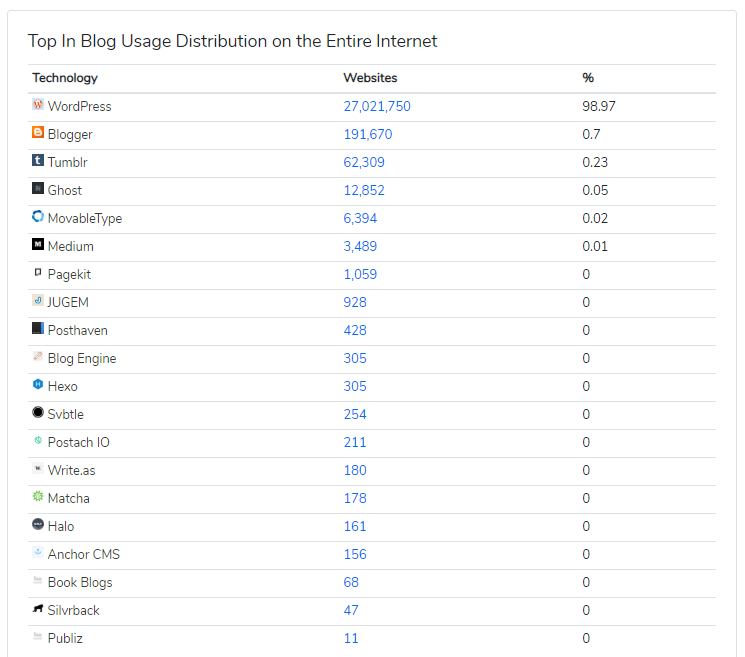
If this isn’t convincing enough, here are some more reasons why you’ll love WordPress as much as I do:
It’s super easy to use – the simplicity is, for me, one of the most satisfying things about using WordPress. There’s no coding required, just click to add content blocks. Even the most non-techy people will find it a breeze
WordPress has a huge support community – there’s just so many people using WordPress, which means if you ever have a problem, chances are you’ll find the solution in one of the WordPress support or developer forums.
It’s easy to add functionality with WordPress plugins – there are thousands of plugins available, allowing you to get your site working exactly how you want to. You can embed multimedia content on your site, such as videos, slideshows, and even podcasts.
But should I choose WordPress.com or WordPress.org?
Great question. I actually like both for different reasons, so I’m going to tell you about both of them. I’ll show you how you can set up your blog in each, and leave the big decision to you. It really depends on how you want to run your site.
The main difference is that WordPress.com is a hosted site, whereas WordPress.org is self-hosted. What this means is that if you opt for WordPress.com, you can sign up for a plan, select a theme, and publish your site. With WordPress.org you will have to buy your domain name and web host separately, and then link everything together.
WordPress.com overview:
It’s an all-in-one platform, which means everything you need to create your blog is built-in. There are no extras to buy (unless you want to upgrade to a premium theme), and no hidden costs.
WordPress.com provide a free plan, although you will probably find yourself upgrading to a paid plan quite soon. There are limitations on storage space, so bear that in mind if you plan on uploading lots of media files.
Updates and backups are taken care of for you. All in all, WordPress.com is the easiest and quickest way to get your blog written and published.
WordPress.org overview:
WordPress.org is more versatile, allowing you to have complete control over the design and management of your site. You can be more hands-on, adding whatever plugins and functionality you want.
WordPress.org is free, but you will have to pay for your domain name and web host. Storage is unlimited, and you fully own your data. You will also have to add a plugin to arrange backups for your site.
To sum it up, WordPress.com is great for anyone looking for a really quick and easy way to start a beautifully designed blog. If you want more control and don’t mind integrating the domain and host yourself, go for WordPress.org. Either way, you won’t be disappointed.
Throughout this guide I’ll try to make it as clear as possible which platform I’m referring to in each step. If anything is not clear, or you have a question, feel free to contact me.
Ok…I’m interested in WordPress.com, but which plan should I choose?
WordPress.com offer a free plan, and four paid plans. Here’s what each offer:
Free
- Jetpack essential features – speeds up your site, protects from spammers, improves SEO, etc.
- Pre-installed SSL certificate – ensures the privacy and safety of traffic visiting your site
- 3GB storage space – determines how many images, audio, etc you can upload to your site
- Dozens of free themes – professionally designed themes to style your site exactly how you want
Personal
Everything included in the above plan, as well as…
- Free domain for a year
- Email and basic live chat support
- 6GB storage space
- Remove WordPress.com ads – visitors can visit your site without seeing any WordPress advertising
- Recurring payments – allows you to accept monthly or annual payments on your website
Premium (the most popular, and the one I use)
Everything above, plus:
- 13GB of storage space
- Unlimited premium themes
- Advanced design customization – extended color schemes, background designs, and complete control over CSS (style sheets)
- Simple payments – allows you to add a PayPal button
- WordAds – earn through ad revenue
- Advanced social media – schedule social media updates in advance
- VideoPress support – an easy way to upload videos to your site, displayed using an unbranded, customizable player
- Google Analytics integration – track visitor stats with Google Analytics
The next two plans are definitely overkill for anyone looking to start a blog, but worth mentioning in case you have anything else planned.
Business
Everything as above, but with:
- 200GB storage space
- SEO tools – tools that enhance your site’s content for better search engine results
- Personalized help – one-on-one help from specialized WordPress engineer
- Install custom plugins
- Upload custom themes
- Remove WordPress footer branding
- Automated backup and one-click rewind – download a backup of your site, or restore it to its exact state in a specific moment in time
- SFTP and database access – upload files (i.e. themes and plugins) to a secure site (SSH File Transfer Protocol) and manage your database with phpMyAdmin
eCommerce
Everything included above, but with advanced eCommerce features:
- Accept payment in 60+ countries – using leading providers such as Stripe, PayPal, etc.
- Integration with top shipping carriers – ship physical products and show live rates from top carriers, like UPS
- Unlimited products or services – grow your store as big as you like
- eCommerce marketing tools – add email and social media integrations
- Premium customizable starter themes
Step 2: Decide on what you’ll call your blog and register your domain name
Ok, hands up if you want to start a blog but don’t know what topic you want to blog about 🙋♀️
If you’re now sitting with your hand in the air, put it down, and then click on the following link where I share my favorite tips on choosing the perfect niche.
For those who already know what they want to blog about, it’s time to think of a name.
A good blog name should be descriptive, but also succinct. Your domain name is your blog’s permanent address, so take your time and make sure you’re happy with it.
Before settling on a name, here are some things to consider.
- What will your blog be about?
- Is it a niche subject or a more general blog?
- Will your chosen name allow you change direction if you vary your niche?
- Using your own name may give you more flexibility, but may not be as SEO friendly as using keywords or a brand name.
Steer clear of words that are difficult to spell or pronounce, and use short words where possible. You can’t use spaces in your domain URL. Words can be “separated” with hyphens (i.e. my-blog) or underscores (i.e. my_blog), but in my opinion they don’t look that great. Also, people may forget to include them when searching for your site.
Write your ideas down in full as this will make sure that your domain doesn’t unintentionally lead to a hilarious URL. Just ask the owners of the Pen Island site (penisland.net) or Swiss Bit (swissbit.ch).
.COM is the most popular domain extension choice, so aim to get this if you can. If you have the perfect name and a .COM extension isn’t available, you could try a .NET or .ORG, or a country specific extension such as .ES.
Once you have chosen your domain name, it’s time to check if it’s available. This is easily done with Instant Domain Search. Just type in your idea and you’ll be told if it’s available or not. You’ll also see a list of alternative ideas.
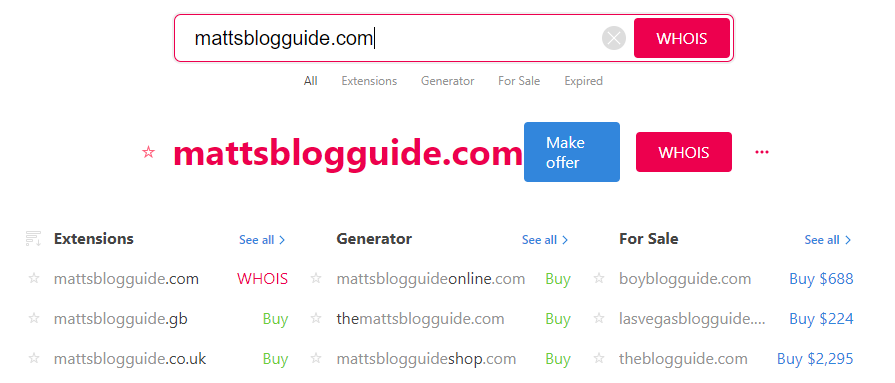
So, you have a domain name in mind, it’s available, and you’re ready to buy. Congrats!
If you chose WordPress.com, you can buy your domain name through them, and skip straight to step 4.
But if you chose WordPress.org, there’s just one last thing to consider.
Step 3: Pick a web host for your blog
WordPress.org only:
Now that you’ve got your domain name sorted, let’s get you online! This might sound the most technical and daunting part of the process, but don’t worry…it’s actually super easy. Just follow the steps below and you’ll be online in two shakes.
The first step is to choose a host. I personally use Bluehost and recommend them to anyone starting a blog. You can register your domain name through them, and they offer one-click WordPress integration.
You can read my full review of Bluehost here, but here are some of the reasons why I love them:
The main reasons I love Bluehost is that they have excellent speed and uptime, the pricing is super competitive, their support team have always been fantastic, and they are one of the top recommended WordPress providers by WordPress themselves.
Click here to head over to Bluehost. In the navbar at the top, hover the mouse over WordPress and select WordPress Hosting from the dropdown menu.
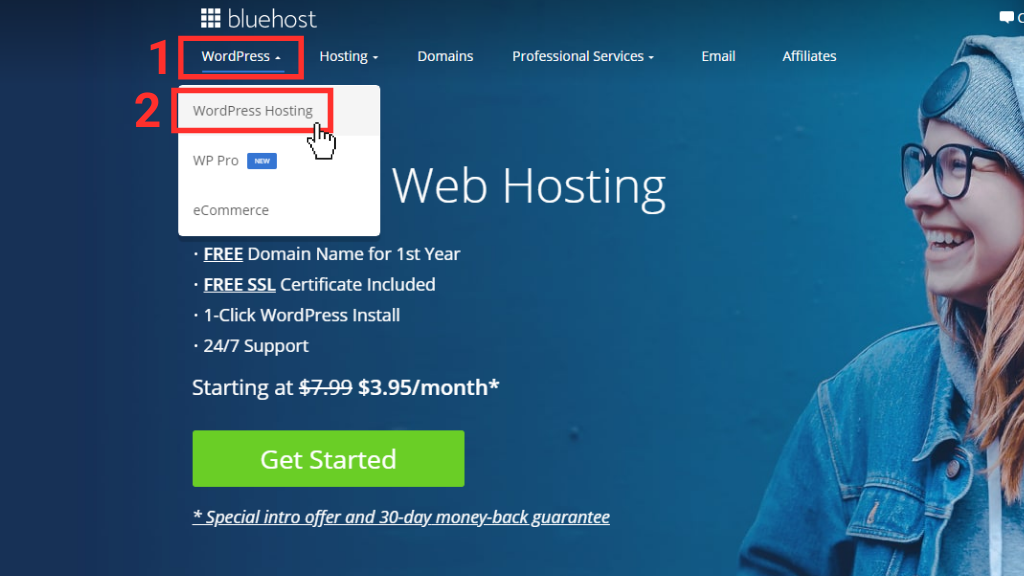
Click on Choose Plan – or just scroll down a little.

Select which plan you would like and click Select.
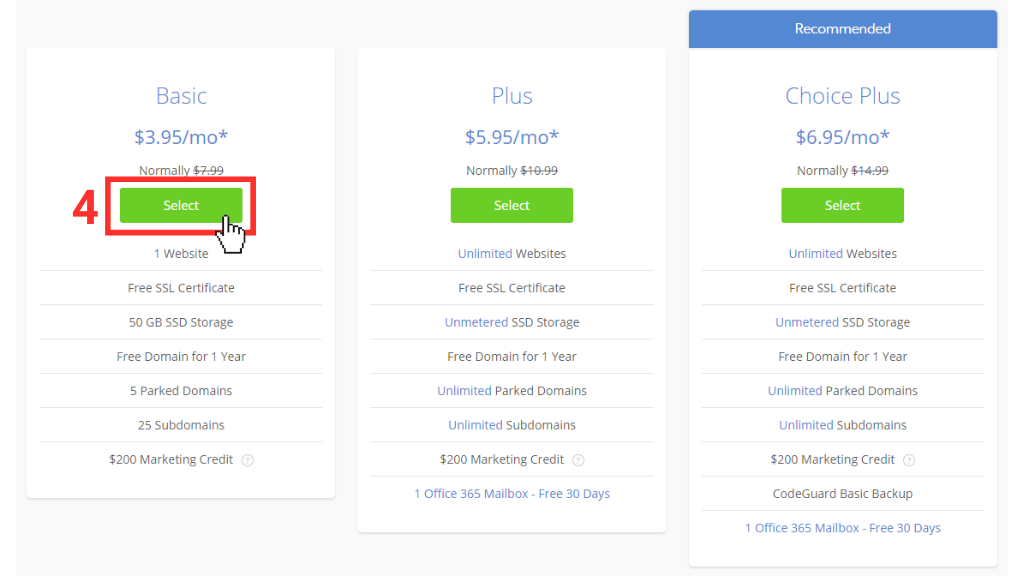
Enter your chosen domain name and extension, and click Next.
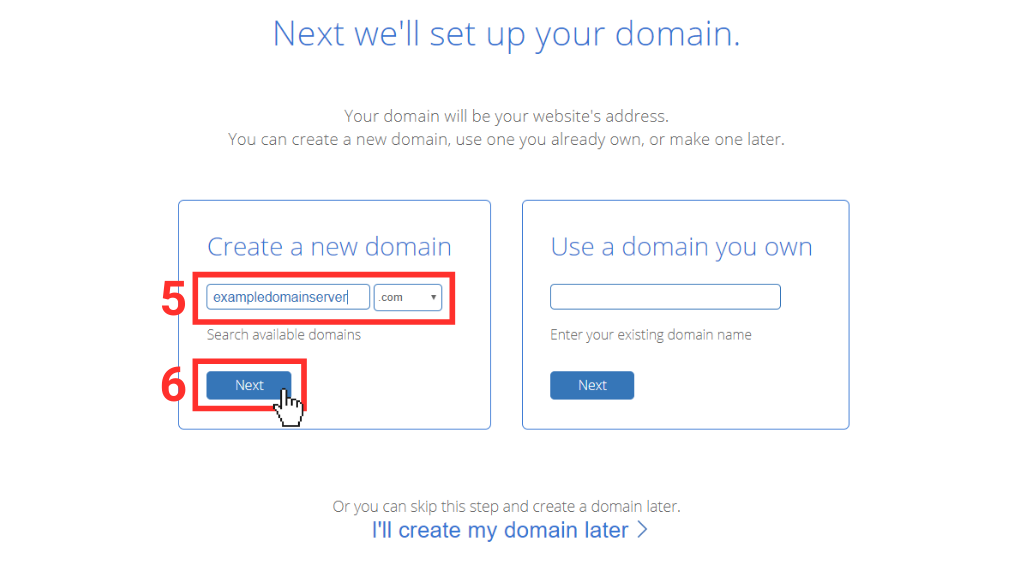
The next screen is where you’ll be asked to enter your account and payment info. Complete all of the required fields and click Submit.
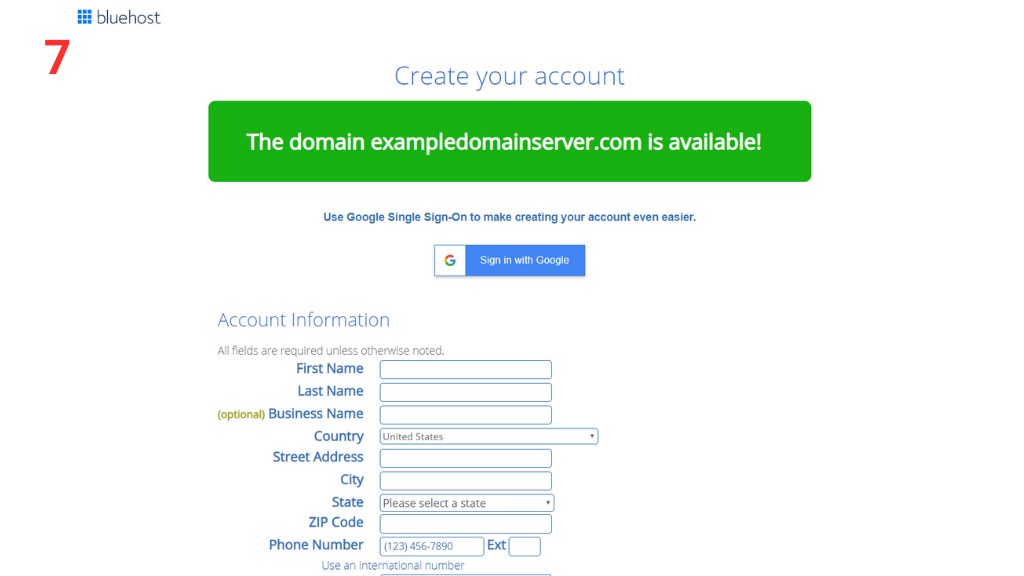

Once you’ve entered your account and payment info, you will be offered package extras. My advice is to uncheck everything except Domain Privacy Protection. You will be able to add the rest of these at a later date if you decide you need them.

Once you’ve chosen your hosting package and filled in your information, click the Next to complete your purchase.
At this point, you’ll be asked to create a password for your account. You need to include the usual – capital and lowercase letters, a number, and a special character (?!#, etc.). When you are all signed up, you can log into your account and start installing WordPress!
Log in to Bluehost and click on Marketplace in the sidebar. Under the Featured Products, click on One-Click Install, find WordPress and click Install
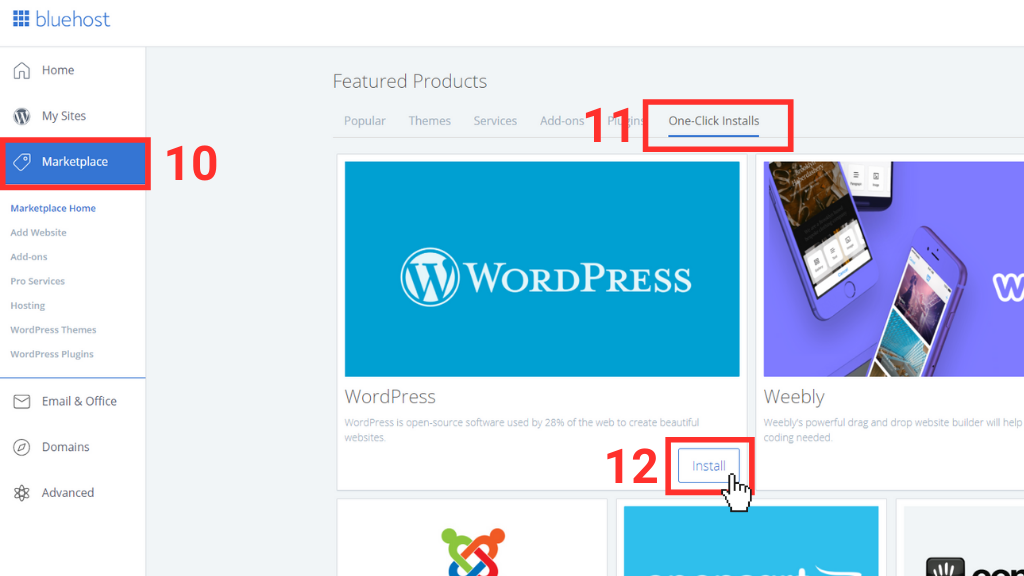
Enter your site name and tagline, and click Next.

Select your domain from the dropdown menu, click Next and watch in wonder as WordPress is installed before your very eyes. Ok, that may have made it sound more exciting than it actually is.
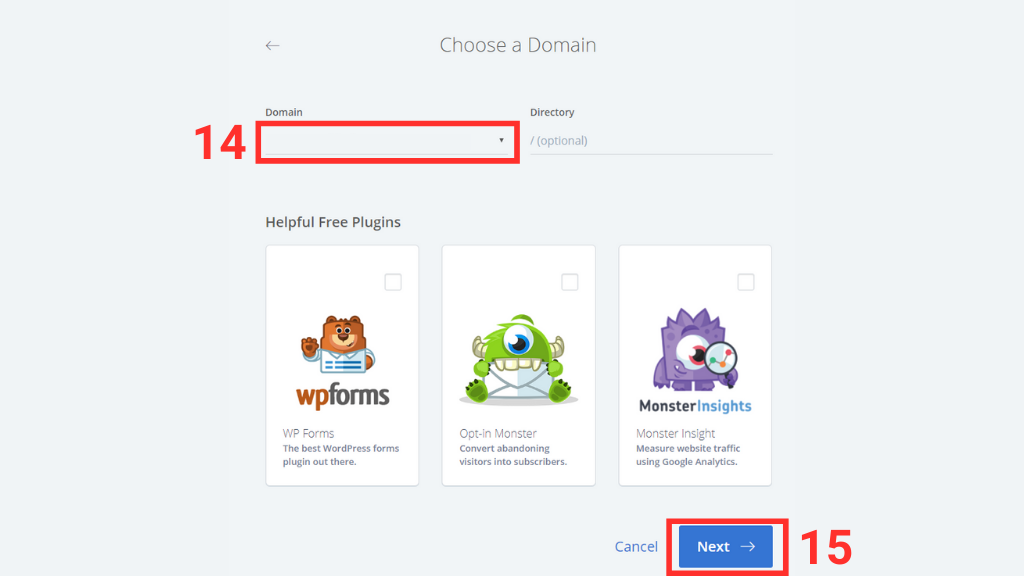
Step 4: Customize your blog with the perfect theme
Congratulations! That last step was a big one to complete, but you got there! There’s just one more thing to do before you get to the fun part of actually writing your blog posts, and that is to choose a theme for your site.
Luckily WordPress has thousands of themes available – access to the premium themes will be dependent on what plan you chose earlier. If you selected the premium plan, you will have access to unlimited premium plans, otherwise they will cost about $30+.
You want your site to look beautiful, with a font that is easy to read, and a flow that is easy to navigate. Your readers will notice the appearance of your blog before the actual content.
There will be a default theme already installed, but you should choose one that is well-matched with your niche. You can search for a theme by keyword, or by feature, layout, columns, subject, or style. I’ll be posting about my favorites for 2020, so look out for that.
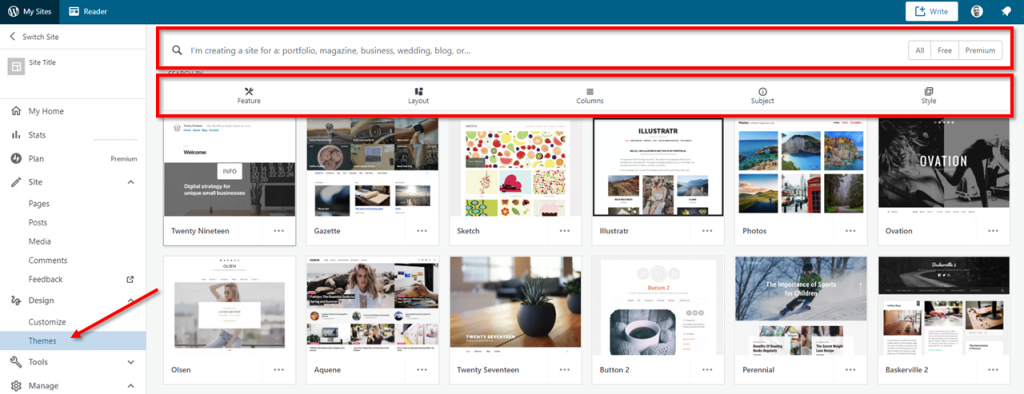
Once you have found a theme you like, make sure to preview it first. Click on the three dots in the bottom corner to open up the options, and then click on Live demo.

Once you have that open, check for responsiveness – how does it look on a mobile device? You can easily check for this by clicking on the dropdown menu on the top left corner and selecting the device you wish to review.
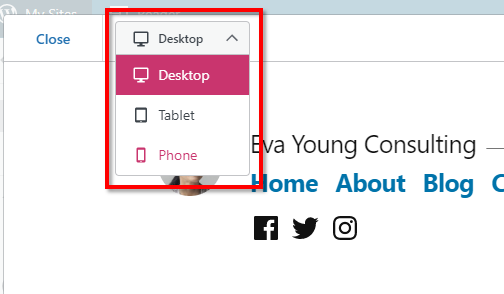
Once you’ve chosen your theme, you’re ready to install it and get to writing your first post!!
Step 5: Write and publish your first blog post
We’re here! Finally, you are ready to start creating content for your blog! It’s been quite a journey, and you’ve made it! Congrats 😊
There are a few static pages you will want to set up before you publish your blog, such as About us, Contact, etc.
About us
Introduce yourself. Explain why you’ve started the blog, and show how passionate you are about your niche.
You don’t need to be an expert. Be honest – if you’re blogging about something you’re learning about, don’t hide that behind some fake guru persona.
Your audience will appreciate your authenticity which will build trust. Some will want to join you on your journey, and may even motivate you.
Your visitors will want to connect with you, so share some of your life experiences.
Contact
You’ll be surprised how many visitors want to contact you, and it’s a great way to build a community. It provides reassurance that you’re a real person. If it’s pertinent, include links to your social media accounts here too.
Now on to your first post!
Your first post should build a foundation for you to build your blog upon. No pressure, but it should captivate your audience and want them to come back for more.
Follow this guide on how to write the perfect first post.
Once you think you’ve finished, take a break. When you come back, read what you’ve written and ask yourself if there’s anything that need improving.
Maybe ask a friend or family member. If spelling and/or grammar is not your strong point, maybe use something like Grammarly to check for errors.
That’s it…
So there it is. If you have followed these steps you should have your first blog posted. If anything is not clear, or if you think I’ve missed something, please do feel free to contact me. I would love feedback of any kind, or just a hi.
If you found this useful and you have published your first blog, please share your link, I would love to see what you’ve done.
Until next time, take care.

Thanks man am in Uganda and I was thinking of opening one but this info is gonna help me a lot.thanks a lot.
LikeLike
Hey Kakooza. Super glad I could help. Give me a shout if you need any help. And please drop a link to your blog once it’s online.
LikeLike
So great Iwas looking for guidance on how to open up a blog ,you have really helped me am in uganda thnx
LikeLike
Hi Muwanguzi. I’m so glad to have helped. Let me know when you launch your blog
LikeLike
I feel motivated already. I’ll contact you should I need any help.
LikeLike
Hey Bonike. That’s great! Drop a link when your blog is live
LikeLike
Hey thanks, I know this will help. You just saved me from undergoing a long journey. Thanks for sharing
LikeLike
Hey Derah! Glad to have helped. Let me know when your blog is up and running 🙂
LikeLike
Good explanatory notes …thanks
LikeLike
Hey Parthajit. Thanks for your comments and for dropping by
LikeLike
This was helpful, thank you.
LikeLiked by 1 person
Hey Emily, thanks for your comment. I’m glad you found it helpful 🙂
LikeLike
Thanks for the information.I know it has helped many.
LikeLiked by 1 person
Thanks Esther! That means a lot 🙂
LikeLike
I feel more motivated now by this guide, I’ve been on serious researches on how to start blogging & I hope to have a functional blog soonest, though I’m still a little bit skeptical about the cost & sustainability.
Hope to get more support from you subsequently.
Thanks!
LikeLike
Hi Uzoking. Thanks for your comments. I’m glad I’ve been able to motivate you. If you’re worried about cost and sustainability, why not try WordPress’ free plan? It will give you enough to get started. You don’t have a domain included, so your URL will be yourblogname.wordpress.com but at least it will help to address any doubts 🙂
LikeLike
Thanks for your timely reply, but I learnt that, it’s not the best to start with the free version as it will cost more larer, migrating to the paid version, together with other challenges.
Kindly clarify me on this. Thanks in anticipation.
LikeLike
Hi Uzoking. I’ve not heard of any problems when switching from a free plan to a paid one. I contacted WordPress support and they also told me that there are no issues. Hope this helps
LikeLike
Hey, its really helpful for me.
but i’m Still confuse with this site,
im from india and this site (wordpress.com) will work for me ?
LikeLike
Hi lavie. I’m glad you found this helpful. Both WordPress.com and WordPress.org will work in India. WordPress.org is the most popular choice as it gives you more flexibility, but WordPress.com is also great. I hope that helps
LikeLike
Very informative. Thnx
LikeLike
Thanks, Shahzad 🙂
LikeLike
I want to start a blog I just wanna ask that Cam we make money by blogging?
LikeLike
Hi Ateeqa. Great question! The simple answer is yes, you can make money blogging. The most popular ways for beginners are with ads and affiliate marketing. I’m actually in the middle of writing my next post which will cover this in detail, so stick around 🙂
LikeLike
Thanks matt, really helpful and simple,I will contact u once am done with it
LikeLiked by 1 person
Thanks Olabisi. I’m looking forward to seeing your blog! 🙂
LikeLike
Site hasnt been launched free . What should i do?
LikeLike
Hi Mdarshadansari. Without having any context it’s difficult to understand what’s wrong. My advice would be to contact WP’s support team. You can have a live chat with them to get your site launched. Good luck 🙂
LikeLike
Pls what will be my greatest challenge has a new blogger and which personal advice can you also give me apart from the one you have written above
LikeLiked by 1 person
Hey James. Great question! It really depends on your individual strengths and weaknesses, as well as outside influences and events. My biggest challenge since lockdown started is actually finding the time to write posts, as my daytime is spent looking after my family and I study in the evening. If you go down the self-hosted route, you might hit a technical roadblock when integrating your host with WordPress, although Bluehost make this as easy as possible. You might have times where you can’t think of posts to write, or it might be that you’re not sure how to increase your traffic and get reader engagement. I will be covering all of these at some point, so I do hope you stick around and I can help you hit the ground running 🙂
LikeLike
Am so happy to learn more.soon I will start my blogging.
LikeLike
Hey Iliya. I’m super glad to have you visit. Let me know when you start your blog.
LikeLike
Hey Matt, thanks for all those infos. But frankly speaking of didn’t read past option 1. I’m a bit hesitant about this whole blog thing. The reason I want to open my own blog cz I wanna share something personal I feel like I can’t say to others, but I need to say. I’m not sure if it’s all right or not. I don’t know what to do?
LikeLike
And I didn’t mean to offend you by saying I didn’t read your whole post..I’m sorry if I have.
LikeLike
Hey rebel9794. No worries…no offense taken. Blogging can actually be one of the best ways to express yourself and remain anonymous. Whatever it is you feel you want to share, my advice is to take a leap of faith and do it. You’ll probably find that you resonate with more like-minded people than you anticipated. One of the best blogs I’ve seen talks about deeply personal subjects such as anxiety and depression. I hope this helps. Take care
LikeLike
I started my blog and I got so much help from this. the best guide post for new bie bloggers.
LikeLiked by 1 person
Hey Tapan! Thank you so much for the amazing feedback! Congrats on starting your blog 🙂 I’m so glad I was able to help.
LikeLike
thank you so much for your support
LikeLike
Hi Ibor. Thanks for your comment. It’s my pleasure 🙂
LikeLike
Hi matt, your blog is great and helped me make my own site and it looks good to me, however i made it on wix
Yourpersonalblogger.com
LikeLike
Boss,I’m a bit confused about everything,can you educate me a bit
LikeLike
Boss,I want to be a blogger but i want some little education since I couldn’t understood this one
LikeLike
Hey Gabriel. Sure, what do you need help with?
LikeLike
Hello, do u think you can assist me to open a blog for my sister please… Am not a computer kind of guy and i would like to surprise her with it.
LikeLike
Hi Muubih. What a lovely idea! I’d be happy to help. Is there anything specific you’re stuck with?
LikeLike
Can I earn from it
LikeLike
Hi Chinedu. Great question! The answer is a resounding yes! Check out this post: https://mattsblogguide.com/2020/05/24/how-to-make-money-blogging/
LikeLike
I like the way you share with us. It’s really good. I was looking for this. Thanks much!!
LikeLike
Hi Annie. Thank you for your comment. I’m really glad you like my guide 🙂 I hope I can continue to help you.
LikeLike
Very informative. It has really saved a lot of time and effort in understanding about starting a blog.
LikeLiked by 1 person
Hey Tarun. Thanks so much for your feedback. I’m super glad it’s helped you 🙂
LikeLike
Thank you very much for this. I’ve chosen a domain but I haven’t written my first blog post yet. The domain is narroweyeblog.com
Thank you very much once again. ♥
LikeLike
Hey! I’m so glad you found it helpful. Let me know once you’ve got your first post up. If you get stuck, this post might help: https://mattsblogguide.com/2020/04/28/how-to-write-the-perfect-first-blog-post/
LikeLike
I love your write up, thank man! But I need your guide lines and assistant to start up my own blog..
LikeLike
Thanks Solomon! What aspects do you particularly need help with?
LikeLike
Well, this is amazing. Trying to become a blogger.
LikeLike
Thanks Hassan! Let me know when you get started
LikeLike
Very interesting and I’m feel motivated how can I manage my blog and I need more education I wish I could open my blog but I own only a smartphone I don’t have a computer or laptop.
LikeLike
Hey Abraham. I’m super glad you’re motivated. I think you can get started with a smartphone but I don’t think it would be sustainable to write long blog posts. I hope you can get a laptop soon and start your blog. Good luck
LikeLike
Your write up is very informative but I will like to know if I can do all that you spoke about on an Android phone.
LikeLike
Hi May. I think it’s possible to get started with a phone, but as I mentioned to another reader, I don’t think it would be sustainable.
LikeLike
Dai छोड़ा I
LikeLike
I have read blogs before but I think I was never this moved that I would end up leaving a comment. I don’t have much to say but man, you are good at this. It’s a quite long post but I sticked till the end. Definitely, it is informative and helpful.
LikeLiked by 1 person
Hey Himani. Thanks so much for your comment. It means a lot! 🙂
LikeLike
Hey love this article.
LikeLike
Hey! Thanks 🙂
LikeLike
Hi, Is the basic plan not free? Or is there a minimum cost that has to be paid?
LikeLike
Hi there. Yes, the basic plan from WordPress.com is free. I hope that helps. Do you have any other questions?
LikeLike
Can you let me know as to where is the option for me to post the blog content
LikeLike
Hey. There should be a blue “publish” button in the top right corner.
LikeLike
Thanks alot Matt this is more than enough
LikeLike